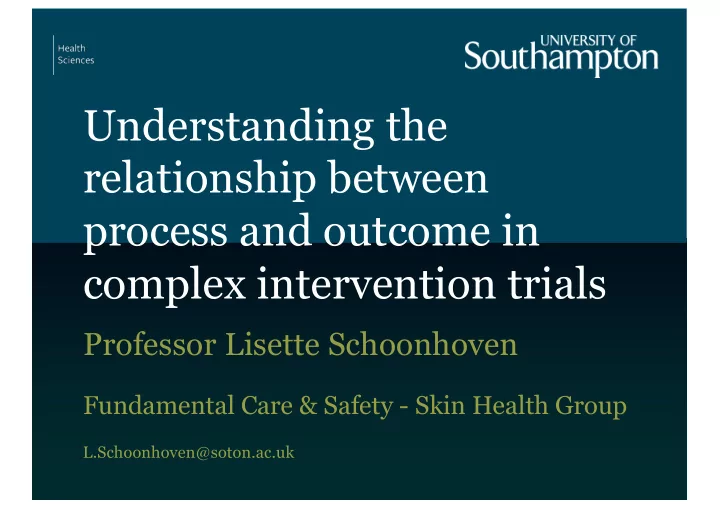

Understanding the relationship between process and outcome in complex intervention trials Professor Lisette Schoonhoven Fundamental Care & Safety - Skin Health Group L.Schoonhoven@soton.ac.uk
Complex interventions • Intervention: any action taken by health care workers (including people working in social care and public health situations) with the aim of improving well-being of people with health and/or social care needs • Complex – What is simple? – Not the intervention but the question is complex: does it work/ how does it work/ what would work in this situation/how can we optimise it? 2
Components of intervention complexity Type of Sub-themes complexity Behaviours Number of different behaviours Parameters of behaviours Methods of organising and delivering behaviours Interactions between behaviours Difficulty of these behaviours for clinicians and recipients Outcomes Number and variability Delivery Degree of flexibility and tailoring MRC (2000, 2008) taken from Richards and Hallberg 2015 3
Process evaluation • Can be used to: • Assess fidelity and quality of implementation • Clarify causal mechanisms • Identify contextual factors associated with variation in outcome 4
Process evaluation • Can be used to: • Assess fidelity and quality of implementation • Clarify causal mechanisms • Identify contextual factors associated with variation in outcome 5
Process evaluation: implementation fidelity (integrity) • Refers to the degree to which an intervention is delivered as intended by the intervention developers (fidelity) • Fidelity influences how far the intervention actually affects the outcomes • The effectiveness of a carefully developed intervention depends on the degree in which it is delivered (dose) 6
Process evaluation: what to measure? Target group/participants • Professional, patients, aimed at individuals or group, size of group, motivation participation Implementer • Professional status, opinion leader, authority Intensity • Frequency, time intervals, duration Information provided • Type of information about performance, presentation form, medium 7
Process evaluation: how to measure? • On-site observation • Self-report techniques (interviews and questionnaires) • Existing data sources or records 8
SAFE or SORRY? an evidence based inpatient safety program for the prevention of adverse events Betsie van Gaal Lisette Schoonhoven Raymond Koopmans George Borm Joke Mintjes-de Groot Theo van Achterberg (Van Gaal et al. BMC Health Serv Res. 2009)
SAFE or SORRY? • Background – Project tiredness and a lack of comprehensive safety thinking • Aim - to develop and test a patient safety program that addresses several AEs simultaneously in hospitals and nursing homes • The program addresses three AEs: pressure ulcers, falls and urinary tract infections
Intervention • Developed with experts, using existing guidelines & supplementary material • Consensus about the essence of the guidelines and formulated bundles of key recommendations • Bundles and indicators discussed with the user group (n=17) • Implementation strategy consisting of * education * patient involvement * feedback through a computerized registration program
Aim Was the SAFE or SORRY? program effective in hospitals and nursing homes? • Did it decrease the incidence of adverse events • Did it increase preventive care
Methods Cluster randomised trial Follow-up Baseline 9 months 3 months Intervention group R 14 months 20 wards Control group
Results Hospitals Nursing homes 272 (8,9%) 152 (8,5%) 97 (6,2%) 174 (6,3%) Intervention Control Intervention Control • In hospitals 43% adverse events & in nursing homes 33% adverse events Conclusion: Simultaneous implementation of multiple guidelines seems feasible and effective
Methods Outcome • Primary: incidence of PUs • Secondary: utilisation of preventive care Data collection • Weekly visits • 5-hours observation
Results: General Hospitals Baseline Follow up Intervention Control Intervention Control Included patients 346 341 1081 1120 Female 184 (53%) 204 (60%) 570 (53%) 646 (58%) Age (mean (st dev) 66 (14.5) 64 (16.9) 66 (14.7) 67 (16.1) Nursing homes Baseline Follow up Intervention Control Intervention Control Included patients 114 127 196 196 Female 70 (61%) 89 (70%) 131 (67%) 126 (64%) Age (mean (st dev) 78 (9.9) 78 (10.8) 80 (9.2) 79 (10.5)
Results: incidence pressure ulcers Hospitals Baseline Follow up Intervention Control Intervention Control (n=346) (n=341) (n=1081) (n=1120) Patient weeks 496 534 1576 1782 Incidence PUs 14 18 45 66 Incidence Rate PU/week 2.8% 3.4% 2.9% 3.7% Multilevel analysis: 0.92 (95% CI: 0.39 to 2.15) Nursing homes Baseline Follow up Intervention Control Intervention Control (n=114) (n=127) (n=196) (n=196) Patient weeks 933 1058 2754 3045 Incidence PUs 29 30 36 97 Incidence Rate PU/week 3.1% 2.8% 1.3% 3.2% Multilevel analysis: 0.34 (95% CI: 0.15 to 0.76)
Results: preventive material Hospitals Baseline Follow up I C I C (n=346) (n=341) (n=346) (n=341) % patients at risk PU 1 46% 50% 49% 52% Pressure-reducing mattress 97% 97% 86% 98% Alternating pressure mattress 2% 3% 1% 1% Pressure- reducing cushion 1% 2% 2% 2% Nursing homes Baseline Follow up I C I C (n=114) (n=127) (n=196) (n=196) % patients at risk PU 2 71% 62% 58% 71% Pressure-reducing mattress 36% 25% 38% 57% Alternating pressure mattress 14% 20% 18% 23% Pressure- reducing cushion 38% 50% 33% 55% 1: PrePURSE or Braden subscale mobility <3 or activity <3 / 2: Braden scale or Braden subscale mobility <3 or activity <3
Results: preventive care Adequate repositioning : • 2-h + no pressure reducing mattress Patients lying • 4-h + pressure reducing mattress • An alternating pressure mattress With or elevated Adequate preventive care heels Adequate repositioning : • 1-h + no pressure reducing cushion Patients sitting • 2-h + pressure reducing cushion Adequate preventive Follow up Estimate 95% CI: care Intervention Control Hospitals 27% 27% 0.06 -0.07 to 0.19 Nursing homes 19% 13% 0.04 -0.05 to 0.13
Discussion • Risk assessment: probably to many patients at risk for PUs, but still not many patients did receive preventive care • Data collection • Not missed: • Incidence of pressure ulcers • Preventive materials • Only an impression of the given prevention
Conclusion The SAFE or SORRY? program: • Decreases the incidence rate of PU in nursing homes • No measured increase the preventive care for patients at risk for PUs
Recommend
More recommend